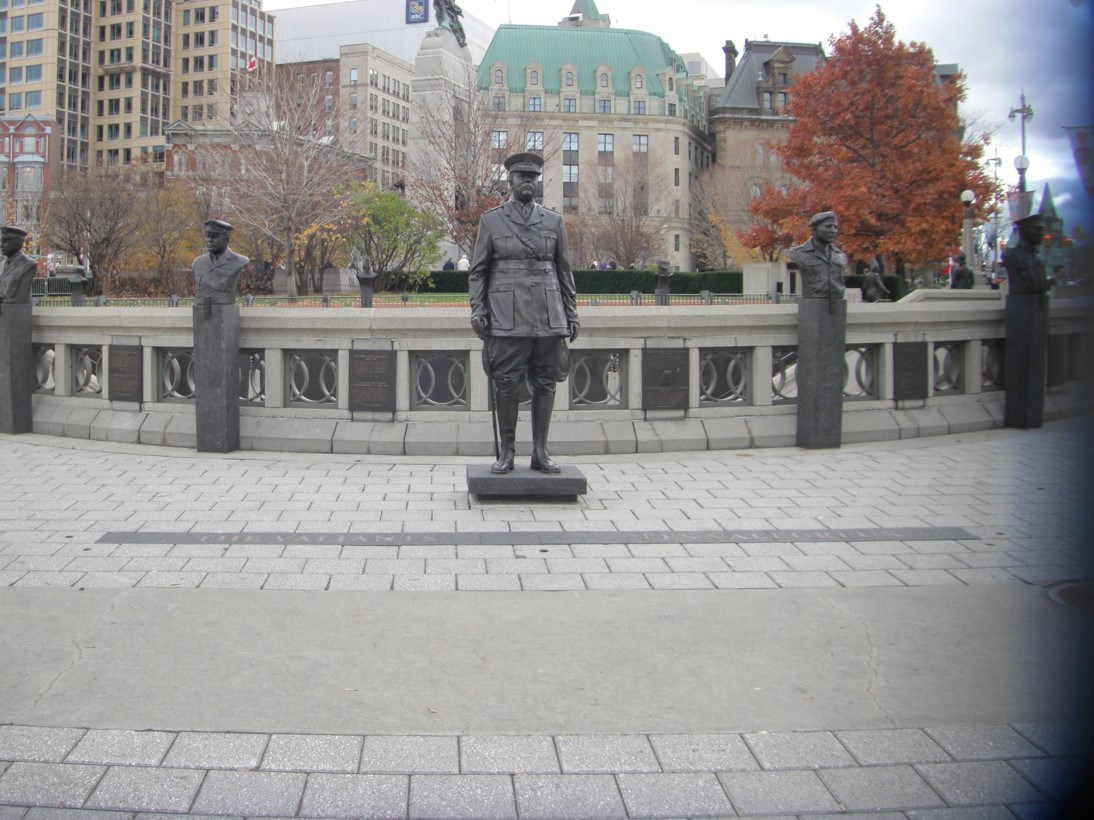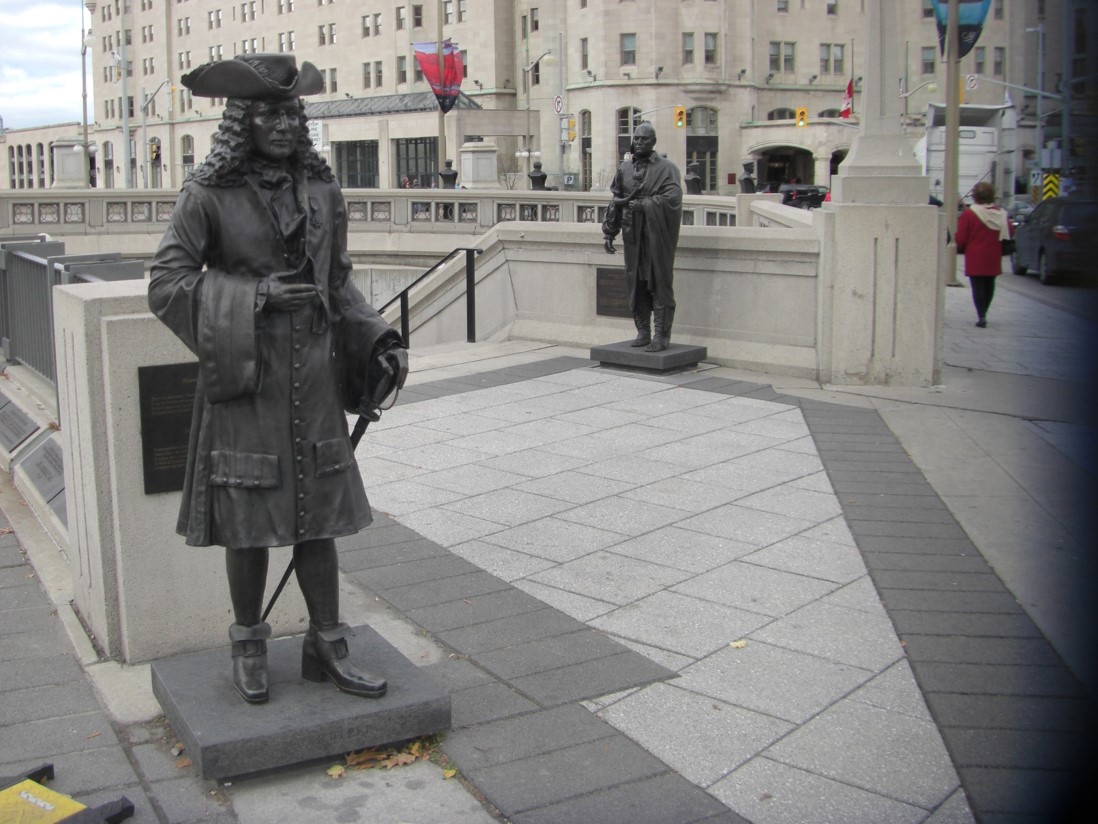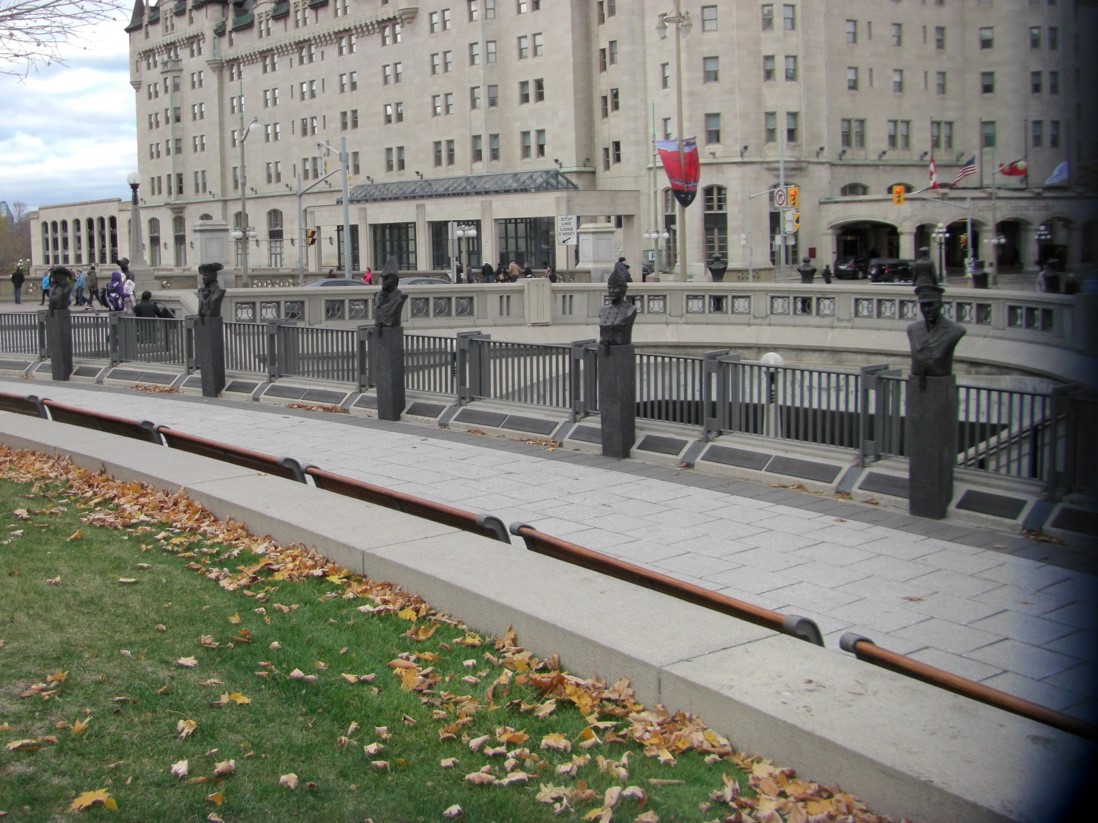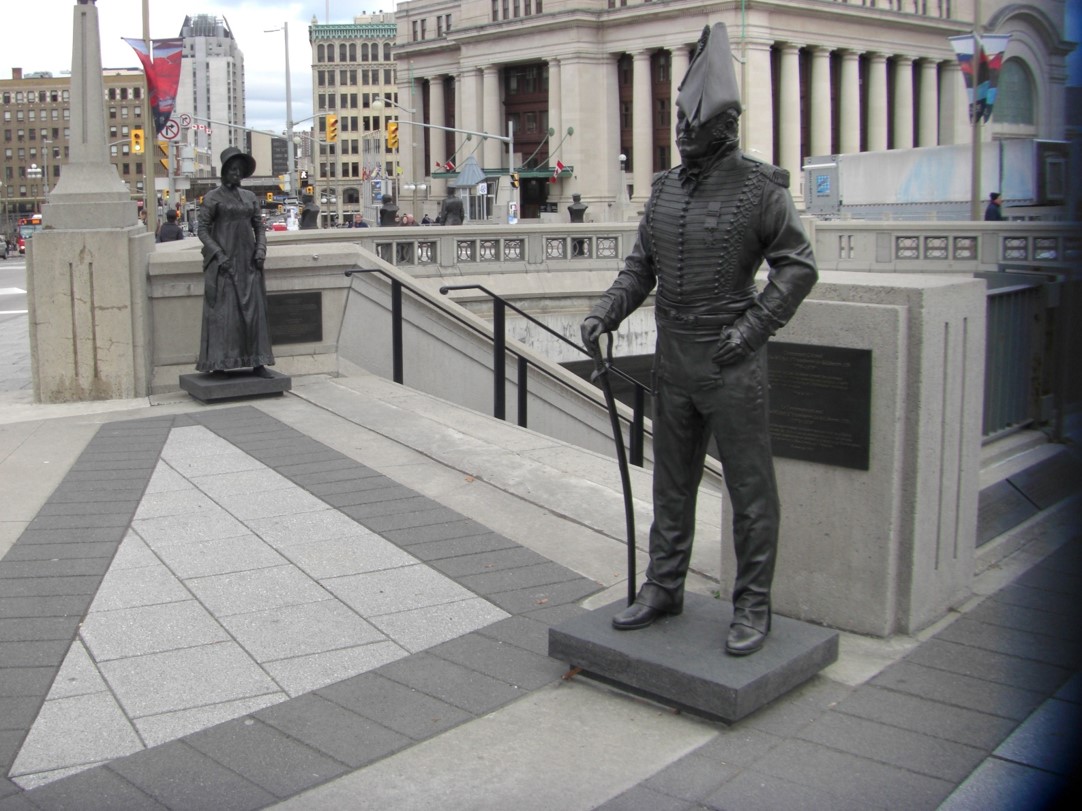[plaque]
From its colonial beginnings in the sixteenth century to its emergence as a modern state in the first half of the twentieth century, Canada has passed through five major periods of war. Each has marked a decisive turning point in the country’s history. The Valiants Memorial commemorates fourteen men and women of remarkable courage, and honours all Canadians who have served this country in war.
Le Canada, entre la colonie qu’il fut au seizième siècle et du pays moderne qu’il est devenu dans la première moitié du vingtième siècle, a connu cinq grandes périodes de guerre. Chacune a constitué un point tournant dans l’histoire du pays. Le Monument aux Valeureux souligne le courage remarquable de quatorze hommes et femmes et rend hommage à tous les Canadiens et à toutes les Canadiennes qui ont servi leur pays pendant ces guerres.
[plaque]
Through the fourteen men and women honoured here, The Valiants Memorial pays homage to all those who have served this country in the wars that have so fundamentally shaped the Canada of today. Artists: Marlene Hilton Moore and John McEwen.
Le Monument aux Valeureux honore quatorze hommes et femmes. Par leur intermédiaire, il rend aussi hommage à tous ceux et à toutes celles qui ont servi le Canada lors des guerres qui ont profondément influencé l’évolution du pays. Artistes : Marlene Hilton Moore et John McEwen.
[plaque]
The Valiants Memorial was unveiled on November 5, 2006, be Her Excellency the Right Honourable Michaëlle Jean, C.C., C.M.M., C.O.M., C.D., Governor General and Commander-in-Chief of Canada.
This monument was made possible with the support of the Valiants Foundation and the Government of Canada.
Le Monument aux Valeureux a été inauguré le 5 novembre 2006 par Son Excellence la très honorable Michaëlle Jean, C.C., C.M.M., C.O.M., C.D., Gouverneure générale et commandante en chef du Canada.
Il a été possible d’ériger ce monument grâce au soutien de la Foundation des Valeureux et du gouvernement du Canada.
[five periods of war represented/cinq périodes de guerre représentés]
[French Regime (1534-1763)/Le Régime français (1534-1763)]
In the many wars between France and Britain during these years, the courage and tenacity displayed by the inhabitants of Acadia and New France ensured the permanency of French-speaking societies in North America.
Le courage et la ténacité des habitants de l’Acadie et de la Nouvelle-France ont assuré la pérennité des sociétés de langue français an Amérique du Nord malgré les nombreuses guerres de l’époque entre la France et l’Angleterre.
[American Revolution (1775-1783)/La Révolution américaine (1775-1783)]
This ruthless, bloody conflict, fought along an extended frontier, divided the continent into two entities: the United States of America and British North America.
Ce conflit, impitoyable et sanglant, s’est déroulé le long d’une frontière étendue et a divisé le continent en deux entités: les États-Unis d’Amérique et l’Amérique du Nord britannique.
[War of 1812 (1812-1814)/ La guerre de 1812 (1812-1814)]
Fought mainly to resolve Anglo-American quarrels, this war marked the successful resistance of British North America to American expansion. It was followed by lasting peace.
Cette guerre, engage principalement pour résoudre des querelles anglo-américaine et caractérisée par la résistance victorieuse de l’Amérique du Nord britannique à l’expansion américaine, a été suivie d’une paix durable.
[First World War (1914-1918)/La Première Guerre mondiale (1914-1918)]
Canada made huge human and economic sacrifices to support Britain and France in this terrible war. The achievements of the national army – the Canadian Corps – won Canada representation at the Paris Peace Conference and recognition on the international stage.
Le Canada a fait d’énormes sacrifices humains et financiers pour soutenir le Grande-Bretagne et la France dans cette guerre effroyable. Les exploits de l’armée nationale – le Corps canadien – ont permis au Canada d’être représenté à la Conférence de la paix de paris et d’être reconnu sur la scène internationale.
[Second World War (1939-1945)/La Deuxième Guerre mondiale (1939-1945)]
In this epic struggle against fascism, Canada mobilized its economy, and sent large land, sea and air forces into battle. With customary bravery, they contributed to victory in every theatre of war. These efforts earned Canada a strong, independent voice in the world.
Dans cette lutte contre le fascisme, le Canada a mobilisé son économie et a engagé dans la bataille d’importants contingents des armées de terre, de mer et de l’air. Avec leur courage habituel, les troupes ont contribué à la victoire dans tous les théâtres d’opérations. Grâce à ces efforts, le Canada a pu faire entendre une voix forte et autonome dans le monde.
[plaque]
Comte de Frontenac (1622-1698)/Le conte de Frontenac (1622-1698)
The most renowned of the governors of New France, he successfully defended Québec from English attack in 1690. Asked to surrender, he memorably exclaimed “I have no reply to make other than from the mouth of my cannon”. French Regime.
Frontenac est le plus connu des gouverneurs de la Nouvelle-France. Il defend Québec contre l’attaque des Anglais en 1690. Sommé de se rendre, il réplique cette phrase célèbre : « Allez dire à votre maître que je répondrai par la bouche de mes cannons. » Régime français.
[plaque]
Pierre Le Moyne d’Iberville (1661-1706)/ Pierre Le Moyne d’Iberville (1661-1706)
Born in Montreal, Iberville was a great commander who fought the English boldly, often against great odds. In 1697, when three English vessels attacked his ship, the Pélican, in Hudson Bay, he sank one, boarded another and then captured their outpost at York Fort. French Regime.
Commandant exceptionnel, né à Montréal, Iberville combat les Anglais hardiment, souvent alors qu’ils sont supérieurs en nombre. En 1697, lorsque trois vaisseaux anglais attaquent son navire, le Pélican, dans la baie d’Hudson, il en coule un, monte à l’abordage d’un autre et s’empare de fort York. Régime français.
[plaque]
Thayendanegea (Joseph Brant) (1742-1807)/Thayendanegea (Joseph Brant) (1742-1807)
A notable Mohawk warrior and statesman, and principal war chief of the Six Nations, he led his people in support of the British. After the war, he brought his people to Canada to settle near where Brantford now stands. American Revolution.
Illustre Guerrier, home d’état Mohawk et principal chef de guerre des Six Nations, il est, avec les siens, un fidèle allié des Anglais. Après la guerre, il conduit son peuple au Canada pour s’établir près de se qui est aujourd’hui Brantford. Révolution américaine.
[plaque]
Lieutenant-Colonel John Butler (1728-1796)/Le lieutenant-colonel John Butler (1728-1796)
John Butler gathered backwoods intelligence, led Aboriginal troops and raised a force of Loyalist refugees – Butler’s Rangers – to fight for Britain. Under his command, the Rangers fought from Kentucky to Niagara, where many settled. American Revolution.
John Butler recueille des renseignements de premier main, mène des Autochtones au combat et lève une troupe de réfugiés loyaliste – les Rangers de Butler – pour combattre aves les Anglais. Sous son commandement, les Rangers se battent depuis le Kentucky jusqu’à la région du Niagara, où bon nombre d’entre eux se sont établis. Révolution américaine.
[plaque]
General Sir Isaac Brock, KCB (1769-1812)/Le général Sir Isaac Brock, K.C.B. (1769-1812)
Commanding the forces of a deeply defeatist Upper Canada, he turned the tide of the American invasion when he captured Detroit in 1812. Although he was later killed in the Battle of Queenston Heights, it was his inspiration, energy and skill that had saved Upper Canada. War of 1812.
Commandant les forces d’un Haut-Canada profondément défaitiste, il renverse le cours de l’invasion américaine en s’emparant de Détroit en 1812. Il est tué plus tard lors de bataille de Queenston Heights, mais son exemple, son énergie et son talent permettront de sauver le Haut-Canada. Guerre de 1812.
[plaque]
Lieutenant-Colonel Charles0Michel d’Irumberry de Salaberry, CB (1778-1829)/Le lieutenant-colonel Charles-Michel d’Irumberry de Salaberry, C.B. (1778-1829)
A skillful professional soldier, Salaberry formed the celebrated Voltigeurs canadiens. In 1813, he outwitted and defeated a vastly superior American force at the Battle of Châteauguay, helping save Lower Canada from invasion. War of 1812.
Militaire de carrière exceptionnel, Salaberry met sur pied les célèbres Voltigeurs canadiens. En 1813, il use de stratégie et défait des troupes américaines largement supérieurs en nombre à la bataille de Châteauguay, contribuant ainsi à préserver le Mat-Canada de l’invasion. Guerre de 1812.
[plaque]
Laura Secord, UE (1775-1868)/Laura Secord, U.E. (1775-1868)
Thanks to Laura Secord, nearly 500 Americans surrendered at Beaver Dams in 1813, and a British defeat was averted. She had overheard plans for a surprise attack and struggled alone through miles of dense bush to warn the commander of the British outpost. War of 1812.
Grâce à Laura Secord, près de cinq cents Américains capitulent à Beaver Dams en 1813, et une défaite anglaise est évitée. Mme Secord avait entendu une conversation à propos d’une attaque-surprise et s’était frayé un chemin, seule, à travers des kilomètres de forêt dense pour avertir le commandant de l’avant-poste britannique. Guerre de 1812.
[plaque]
Matron Georgina Pope, RRC (1862-1938)/L’infirmière-major Georgina Pope, R.R.C. (1862-1938)
A pioneering Army nurse, she was the first Canadian awarded the Royal Red Cross for conspicuous service in the field and, in 1908, became the first matron in the Canadian Army Medical Corps. She later returned to the battlefield in 1917 in France. First World War.
Infirmière militaire pionnière, elle est la première Canadienne à recevoir la Croix-Rouge royale, pour service insigne sur un champ de bataille et, en 1908, elle devient la première infirmière en chef du Corps de santé de l’Armée canadienne. En 1917, elle retourne sur les champs de bataille en France. Première Guerre mondiale.
[plaque]
General Sir Arthur Currie, GCMG, KCB, VD (1875-1933)/Le général Sir Arthur Currie, G.C.M.G., K.C.B., V.D. (1875-1933)
A courageous and innovative officer, he helped plan the great victory at Vimy Ridge. Then, as the first Canadian commander of the Canadian Corps, his brilliant leadership produced the sweeping Canadian victories of the War’s Last Hundred Days. First World War.
Officier courageux et inventif, il contribue à planifier la grande victoire à la crête de Vimy. Puid, à titre de premier commandant canadien du Corps canadien, son leadership remarquable permet aux forces canadiennes de remporter des victoires éclatantes pendant les cent derniers jours de la guerre. Première Guerre mondiale.
[plaque]
Corporal Joseph Kaeble, VC, MM (1892-1918)/Le caporal Joseph Kaeble, V.C., M.M. (1892-1918)
Near Arras, France, with the 22nd (French Canadian) Battalion in June 1918, the only one of his section unwounded, he leapt to the parapet with his machine gun and single-handedly repulsed some 50 attacking Germans. He was fatally wounded and posthumously awarded the Victoria Cross for his courage. First World War.
En juin 1918, près d’Arras, en France, ce membre du 22e Bataillon (canadien-français), seul de sa section à ne pas être blessé, saute par-dessus le parapet avec sa mitrailleuse et repousse à lui seul une cinquantaine d’Allemands. Blessé mortellement, il recevra la Croix de Victoria à titre posthume pour son courage. Première Guerre mondiale.
[plaque]
Captain John Wallace Thomas, CBE (1888-1965)/Le capitaine John Wallace Thomas, C.B.E. (1888-1965)
This Newfoundlander demonstrated heroism during his service in the Merchant Navy in two world wars. In 1940, as Captain of the Empress of Scotland, he maneuvered brilliantly under an air attack off Ireland, saving the ship and the troops on board. Second World War.
Ce Terre-Neuvien sert dans la marine marchande avec héroïsme au cours des deux guerre mondiales. En tant que capitaine de l’Empress of Scotland en 1940, il manœuvre habilement lors d’une attaque aérienne au large de l’Irlande et sauve le navire et les troupes qu’il transporte. Deuxième Guerre mondiale.
[plaque]
Lieutenant Hampton Gray, VC, DSC (1917-1945)/Le lieutenant Hampton Gray, V.C., D.S.C. (1917-1945)
A Canadian pilot serving with the Royal Navy’s Fleet Air Arm, and previously decorated for heroism, both in Norway and the Pacific, he earned a posthumous Victoria Cross in August 1945. Despite intense enemy fire, he attacked and sank a Japanese destroyer before his aircraft went down in flames. Second World War.
Pilote canadien servant dans l’aéronavale de la Marine royale, décoré auparavant pour son héroïsme en Norvège et dans le Pacifique, il recevra la Croix de Victoria à titre posthume en 1945. Malgré le feu nourri de l’ennemi, il bombarde et coule un contre-torpilleur japonais avant que son avion s’embrase. Deuxième Guerre mondiale.
[plaque]
Major Paul Triquet, VC (1910-1980)/Le major Paul Triquet, V.C. (1910-1980)
Triquet earned the Victoria Cross in 1943 for capturing Casa Berardi in Italy, a position of great tactical importance. Surrounded he told his men: “there is only one safe place – that is on the objective.” When he dashed forward, the men followed. Second World War.
Triquet reçoit la Croix de Victoria en 1943 pour s’être emparé de Casa Berardi en Italie, un poste d’une grande importante tactique. Cerné par l’ennemi, il avait dit à ses hommes : « Il ne reste qu’un endroit sûr, l’objectif ». Lorsqu’il s’est lancé à l’attaque, ses hommes l’ont suivi. Seconde Guerre mondiale.
[plaque]
Pilot Officer Andrew Mynarski, VC (1916-1944)/Le sous-lieutenant d’aviation Andrew Mynarski, V.C. (1916-1944)
An air gunner on a burning Lancaster bomber, he made heroic but unsuccessful efforts to save his trapped comrade, the rear gunner. The latter, who finally told Mynarski to save himself and bail out, miraculously survived the crash. Mynarski died of his burns. He was posthumously awarded the Victoria Cross. Second World War.
Mitrailleur dans un bombardier Lancaster en flammes, il fait de vains efforts héroïques pour libérer le mitrailleur arrière, bloqué à son poste. Celui-ci, qui finit par dire à Mynarski de sauver sa propre vie et de sauter en parachute, survit miraculeusement à l’écrasement. Mynarski meurt de ses blessures et recevra la Croix de Victoria à titre posthume. Deuxième Guerre mondiale.



